[TABLE TALK] Norway sails the seas with a hand from Korea
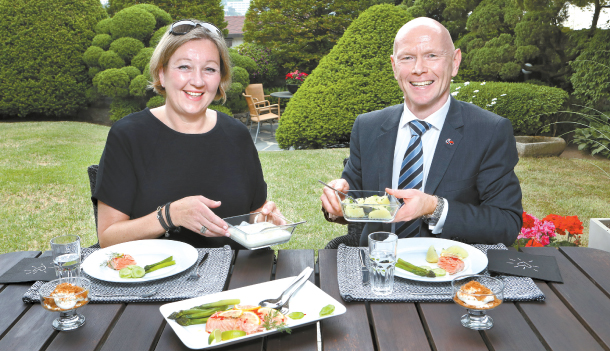
Norwegian Ambassador to Korea, Frode Solberg, right, and his wife Herta Solberg, discuss the Hurtigruten sea voyage that travels along the west coast of Norway, during the interview with the Korea JoongAng Daily at their residence in central Seoul on May 13, over signature dishes of the country. [PARK SANG-MOON]
We are asking these questions to ambassadors in Seoul for our latest public diplomacy series, “Table Talk.” The book, its author and what they say about the country is discussed over a table full of national dishes. What better way to start an exploration of a new land than through food, good writing and a personal guide dedicated to building bridges between countries - right here in Korea? - Ed.
The soul of Norwegian fjords is one hard to forget for those who have gazed upon it once.
“There are many regulars on the trip of Hurtigruten, because the trip leaves each voyager with something new,” said Frode Solberg, ambassador of Norway to Korea. “It is a beautiful journey - you will see the fjords and steep mountains rising from the sea some 1,200 meters [around 4,000 feet] high, as well as the small and the big cities along the way. The trip has been regarded as the most beautiful sea voyage in the world.”
The Hurtigruten departs daily from Bergen, a historic town harboring the footprints from the Hanseatic Era, and travels through fjords and valleys along the western coast of Norway to the northern tip of Kirkenes, before returning in the journey of 11 days.
But the coastal express, which began its first journey in 1893 for transportation of posts, goods and people in Norway, has also stood for something more than a voyage.
“The meaning of Hurtigruten is to keep Norway alive,” said Solberg. “To understand its importance, it would be useful to know that Norway has been focusing on keeping people on every part of the country.”
“The Hurtigruten stops on small places along the coast, like Risøyhamn, which has a population of around 350 people,” said Herta Solberg, wife of the ambassador. “It allows the daily means of communications and business for all parts of the country.”
Norwegians have built railways to connect the remote communities with the mainland area. The Flam Railway, for instance, stretches 20 kilometers (12.5 miles) long from Aurlandsfjord, slightly northwest of Oslo, to Myrdal, cutting through the mountains in 20 tunnels.
“It’s a long country and people live especially along the coastline and it’s not easy for them to get to mainland,” said Frode Solberg. “The railways and the Hurtigruten made it possible for people to live where they want to live.”
Sailing past more than 100 fjords and 1,000 mountains of Norway, the ones aboard the Hurtigruten will also get a glimpse of the everyday life of some Norwegians as it makes port at 34 locations.
“In the Lofoten Islands you can spend a night in one of those old fishing huts by the coast, built from ages ago so that a part of hut is on land and a part of it is over the sea,” said Herta Solberg. “People living there would put out the fishing hook from the hut and get their food that way. The huts have been kept the way they were and it would be a genuine experience of the Norwegian way of life on the island.”
The Solbergs discussed the Norwegian ways of life by the sea over plates of grilled king crab legs and baked salmon taken with Sandefjord butter, reliving the tales and legends of Norwegian seafarers and explorers in the dining room of their residence in central Seoul on May 13.
The following are edited excerpts of the interview.
Q. How did you come to select the book, “The Norwegian Coastal Voyage Hurtigruten: Detailed 11-day Voyage Guide,” for the Table Talk interview?
A. Frode Solberg: I spent quite some time in selecting the book. I was looking for something that could describe the history of Norway and the Norwegian sailors because Korea and Norway share maritime traditions. I thought this book would provide the glimpse into what Norway looks like as well as its values because the coastal express, Hurtigruten, is a picturesque voyage to take in the nature of Norway and at the same time is a long-standing tradition of Norway that has been crucial for the survival of small communities.
Herta Solberg: For instance, the salmon that we are eating now may come from a very small place on the coast of Norway, with not too many people living there. Many of these places can contribute quite a lot to the national economy because they are well connected.
What will people see during the voyage?
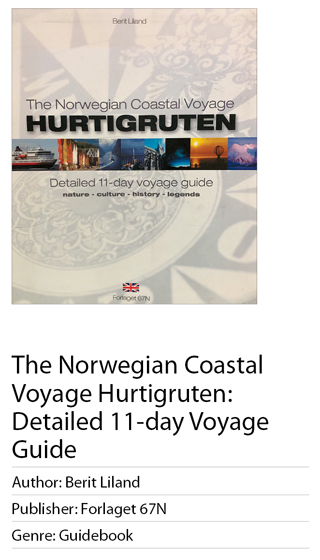
“The Norwegian Coastal Voyage Hurtigruten: Detailed 11-day Voyage Guide” provides a day-by-day guide on the over 30 ports and sites visited during the journey. The book touches upon the nature, history, legends and culture of Norway enjoyed by millions of travelers on the coastal voyage and provides maps and photos of places to see during the journey that can be perused prior to, or during, the travel.
Herta Solberg: In the Lofoten Islands, you can spend a night in one of those old fishing huts by the coast, built from ages ago so that a part of hut is on land and a part of it is over the sea. People living there would put out the fishing hook from the hut and get their food that way. The huts have been kept the way they were and it would be a genuine experience of the Norwegian way of life on the island.
Frode Solberg: It is one thing to take the journey in the summer time and to do it in the winter. In the summer you will experience the midnight sun and in the winter the northern lights - the lighting is really magical because the sun doesn’t come at all and you have these blue and red lights streak across the sky.
Would you say the sea has been very much part of the Norwegian way of life?
Frode Solberg: I think about 90 percent of Norwegians live less than 10 kilometers from any sea and we have always been a country of fishermen and seafarers. You know the old Vikings discovered America many hundred years before Christopher Columbus. Leif Erikson discovered America. The maritime aspect of living from the oceans, by the oceans, and of the oceans, that has been the Norwegian way of life.
Herta Solberg: And if you look into the history of explorers from Norway, there is Fridtjof Nansen who was the first to cross over the interior of Greenland in 1888, and Roald Amundsen who was the first person to reach South Pole in 1911. The vessel used by both explorers, “The Fram,” is showcased at a museum in Oslo. Another vessel called “Gjøa” that was used by Amundsen through the Northwest Passage is also kept at a museum in the city. In fact, when it comes to shipbuilding, it would be interesting to take a look at the Viking Ship Museum in Oslo if you can get a chance.
What’s the latest on cooperation on shipbuilding between Norway and Korea?
Frode Solberg: South Korea is a very important shipbuilding country for Norwegian ship owners. We see the most advanced and biggest ships being built in Korea, and just as we speak, 24 Norwegian ships are on order and under construction. We have longstanding relations with the shipbuilders here, including DSME [Daewoo Shipbuilding & Marine Engineering], Samsung and HHI [Hyundai Heavy Industries], which also explains why a large portion of the Norwegian population in Korea are in the southern areas including Busan, Geoje and Ulsan. We are also working together on the oil and gas installations.
What areas in bilateral relations are you hoping to expand in the future?
Frode Solberg: We have ongoing cooperation in the maritime areas, but we are expanding more on renewable energy and fourth industrial revolution technology, like smart shipping, green shipping and smart cities. They are high on the agenda and it is where we have many areas on common ground.
Herta Solberg: To add, regarding future technology, Korean electric vehicles (EV) are very popular in Norway - they meet a segment in the country because the SUVs are the right size for a family and they have a long range. And the EVs have become the more affordable option because there are no taxes on them.
Norway is a strong oil exporting nation, yet it has focused on developing other forms of energy.
Frode Solberg: From an energy point of view, we have had luck with nature, not only in oil and gas, but we have had vast amounts of hydropower possibilities. In addition to this, we had politicians and organizations with the vision to not depend too much on oil and gas and to realize that these resources need to go hand in hand with others.
In Norway, we also believe that the revenue from oil and gas industry should be used for the future of Norway. So we have set up the oil fund in 1990 to ensure the revenue is saved and expanded for the future generations. The fund, with the market value of over 9 trillion krone [$1 trillion], has been used to invest in more than 9,000 companies around the world.
What about today’s dishes are particularly Norwegian?
Frode Solberg: So the salmon is a very important product when it comes to Norwegian seafood exports to Korea. It is quite a common ingredient in dishes in Norway, though back when we were young it used to be cod.
Herta Solberg: When we grew up there was much more cod in the market - so on special occasions like May 17 celebration and others we would have salmon. But now it is the opposite. Cod has become rarer as we have come to successfully breed salmon in fisheries. I remember, (laughs), that we would say as a kid, “Oh, but we always have cod.”
Frode Solberg: I remember, too, it would be, say, “Tuesday Cod Day,” and kids would say, “Oh, what a boring dinner!” But coming back to the dishes, if we say that salmon is enjoyed more on a daily basis, king crab would be prepared for more special occasions.
The dessert has a peculiar name to it.
Herta Solberg: “Veiled Farmer’s Girl” is a literal translation of the dessert that our chef coined. We had a good laugh about it because it sounds quite unique. The dessert is from the countryside of Norway. You take the leftover cake pieces, crumble them, maybe fry them a bit over the pan, then you make the apple sauce and cream and you put them all in layers. It is very much loved in the country.
Any events about Norway to look out for in Seoul?
Frode Solberg: We just celebrated the Constitution Day on May 17 in Seoul - which was also celebrated with a parade with children from Norway in Busan in the previous weekend. Coming up, we have an opening exhibit about the Norwegian hospital in Korea, Normash, on May 28 at the War Memorial of Korea. And on June 27 there is the next NORDtalks event, where a Norwegian explorer will come and speak about his latest adventures.
Grilled king crab legs with lime herb butter
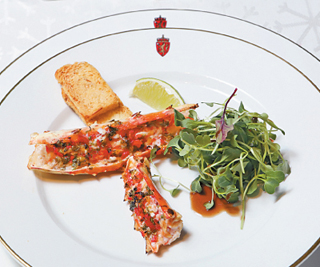
1. Lime herb butter: mix 7 ounces of softened butter and one red chili, 2 tablespoons of fresh tarragon, chopped, 1 tablespoon of parsley, chopped, one garlic clove, minced, 2 tablespoons of lime juice and 1 tablespoon of grated lime zest until well combined. Set aside until ready to use.
2. Preheat a grill oven to 500 degrees Fahrenheit.
3. Wash and clean six king crab legs. Pat dry with kitchen paper towel, split down the center of the crab legs and brush the herb butter to the meat.
4. Arrange the crab legs on the baking tray, meat side up. Grill for 5-7 minutes or until hot and bubbly. Serve crab legs with lime wedges and lime herb butter.
Baked Norwegian salmon with Sandefjord butter
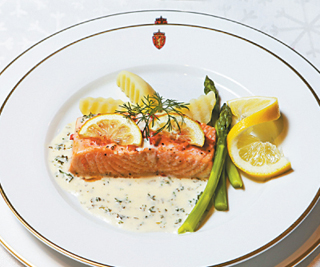
1. Preheat oven to 375 degrees Fahrenheit.
2. Wash two sliced fresh Norwegian salmon with cold clean water, pat dry with kitchen paper towel.
3. Drizzle some olive oil, season with salt and pepper and sprinkle one red chili, chopped. Put sliced lemon on top.
4. Bake salmon for 8-10 minutes.
5. Serve with Sandefjord butter and boiled potatoes.
6. Sandefjord butter: Pour 3 decilters (0.3 liters) of heavy cream in a saucepan and bring to a boil. Take away from heat, add 5.3 ounces of butter. Add 1 tablespoon of Italian parsley or any fresh herbs you like, chopped. Add salt and pepper. Serve immediately.
Veiled Farmer’s Girls
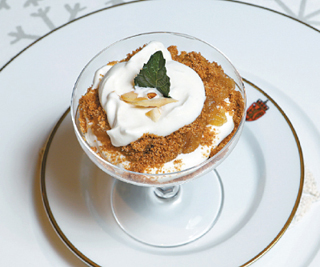
1. In a frying pan, stir together 1 1/2 cups of digestive biscuits, processed, 3 tablespoons of white sugar, 2 teaspoons of cinnamon powder and 2 tablespoons of unsalted butter. Take away from the heat and set aside.
2. Apple sauce: Peel, core and chop five apples. Put in a pot, add 1/2 cup of water, 1 tablespoon of lemon juice, 1/3 cup of granulated white sugar, 1/2 teaspoon of cinnamon powder and a pinch of salt. Stir until combined.
Bring to boil and then lower the heat. Simmer for 30-40 minutes then mash.
3. In a bowl, put 1 1/2 cups of whipped cream, add apple sauce and then digestive biscuit. Do this twice and top the layer with whipped cream. Sprinkle chopped nuts on top if you wish.
BY ESTHER CHUNG [chung.juhee@joongang.co.kr]










with the Korea JoongAng Daily
To write comments, please log in to one of the accounts.
Standards Board Policy (0/250자)